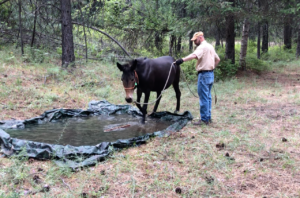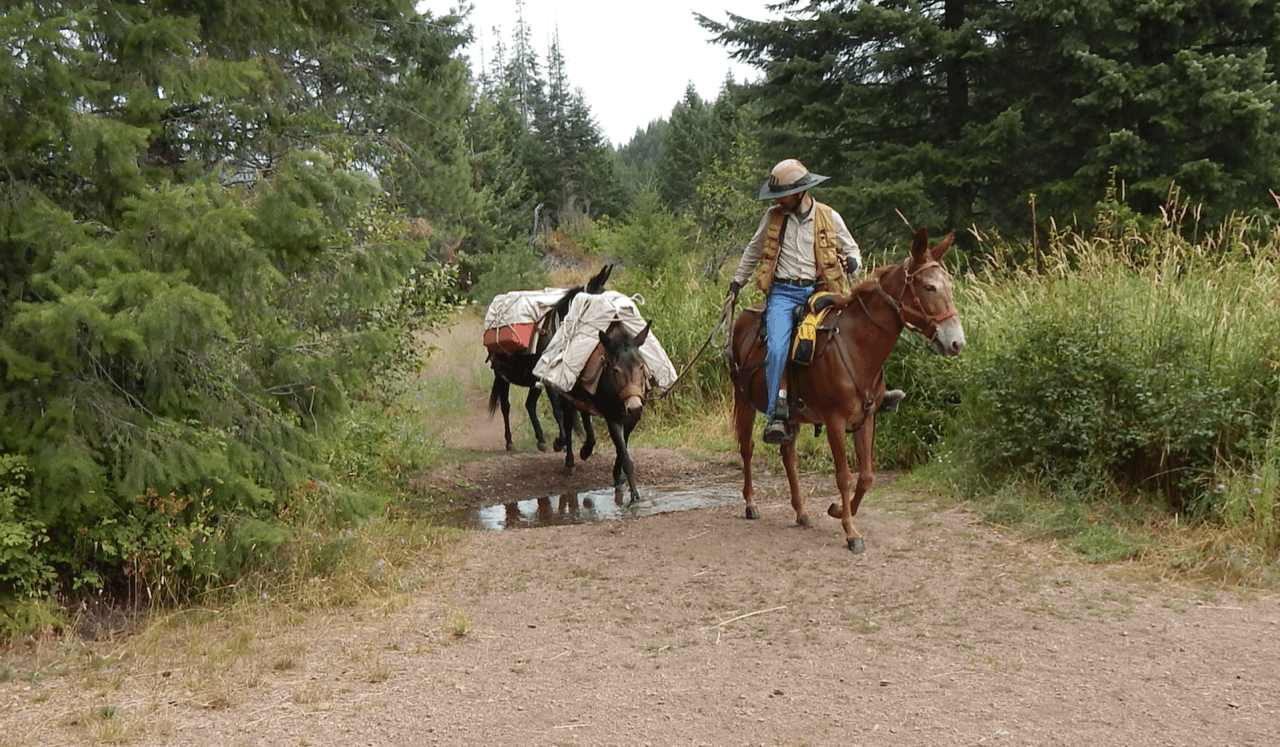Dihydrogen monoxide is colorless, odorless, tasteless, and kills uncounted thousands every year. My mule Cocoa knows this and has consistently refused to get anywhere near the stuff. Unfortunately, her job description requires her to frequently cross bodies of the substance.
Dihydrogen (H2) monoxide (O) is of course water, and water crossings are the bane of many trail riders. Cocoa and I are no exception as I discovered during one of her first packing experiences. A tiny stream that I could easily step across in one stride, and shallow enough that if I were to walk through would not touch the top of my shoes, was enough to derail the ride in short order.
Thank you, Cocoa, for the opportunity! Preparing a horse or mule to steadily and self-confidently cross water takes planning, patience, and practice. This is how Cocoa and I went from refusing puddles to confidently crossing rivers.
Planning
Instinct tells Cocoa that bodies of water are full of alligators ready and waiting to turn her into lunch. So, all things considered, she’d much rather stay high and dry, thank you very much. To turn this landlubber into a veritable seadog, some planning and forethought is required.
Living on the edge of a desert (it’s true, most of Washington State is high desert) I have to drive over an hour to get somewhere with a reliable water crossing. I wanted to make it easier to get to water obstacles at home. In this case, I started with a tarp and a running hose. After that hurdle we progressed to a natural depression in the ground that I filled with water. Neither of these bears much resemblance to a moving stream, but they’re the closest I can get without driving or hiring an excavator. Once Cocoa’s doing well with our faux stream we’ll start hauling to a real river and continue our training efforts there.
Patience
Cocoa’s fear of strange water is natural, and I want to use our training to fill in the Cocoa coloring book with as many positive experiences as possible. To me this means looking at our training efforts as an ongoing process vs. a singular event and using methods that acclimate her to new challenges in degrees.
In this I try to make our desired outcome—crossing the water—the easiest solution. For example, as long as Cocoa is facing the water, we’re good. When she plants her feet and refuses to step forward willingly, we move our feet. I may not be able to make her step forward, but I can certainly make her take a step to one side or another — and in the process, move ever so slightly closer to the water hazard. With every step closer to the water I release the pressure and praise her. I call keeping her feet moving when she’s not ready to stand quietly in the water; it’s a yo-yo game.
Once she’s relaxed, we try for another step. And another. Then another after that.
Practice

Once we’ve gotten that first crossing under our belt (or is that cinch?) it’s time to reinforce the skill with practice and grow the size of Cocoa’s happy place. Once she was good with a watery tarp, we moved to a water filled depression in the yard, then to a small rivulet in a trail, then to an honest-to-goodness river crossing. Each subsequent success was built upon the accomplishment of the obstacle before it.
By varying the type of water obstacle (depth, current, clear vs. muddy, narrow stream vs. wide river) I’m teaching Cocoa that water is water, regardless of type. I believe this generalization will help us when approaching different water passages in the future.
Water crossings are going to happen. We’ll all be better off if we make the time and effort now to acquaint our horses and mules to this fact of trail riding now and on our terms.
My method seeks to avoid a battle of the wills and instead tries to make the obstacle an area of rest and relaxation. It takes time but avoids drama.
As always, for more information on trail riding and camping with horses as well as the world’s largest guide to horse trails and camps in the world please visit www.TrailMeister.com.
See this article in the 2020 October online edition:

Robert Eversole, ”the trail meister,” owns www.TrailMeister.com, the largest database of horse riding and camping areas in the U.S. with free trail and trailhead information, trail maps, and much more to help horse enthusiasts experience the joys of trail riding. Robert is a registered riding instructor with PATH International, a mounted search and rescue team member, and a U.S. Marine who has served on the board of the Backcountry Horsemen of Washington (BCHW). He is enjoying his new career helping fellow trail riders stay found and safe on the trail. When not on the trail, The Trail Meister resides near Spokane, WA and teaches land navigation to a wide variety of outdoor groups across the nation. For North America’s largest horse trail and camping directory, trail tips, and more, visit www.TrailMeister.com.






